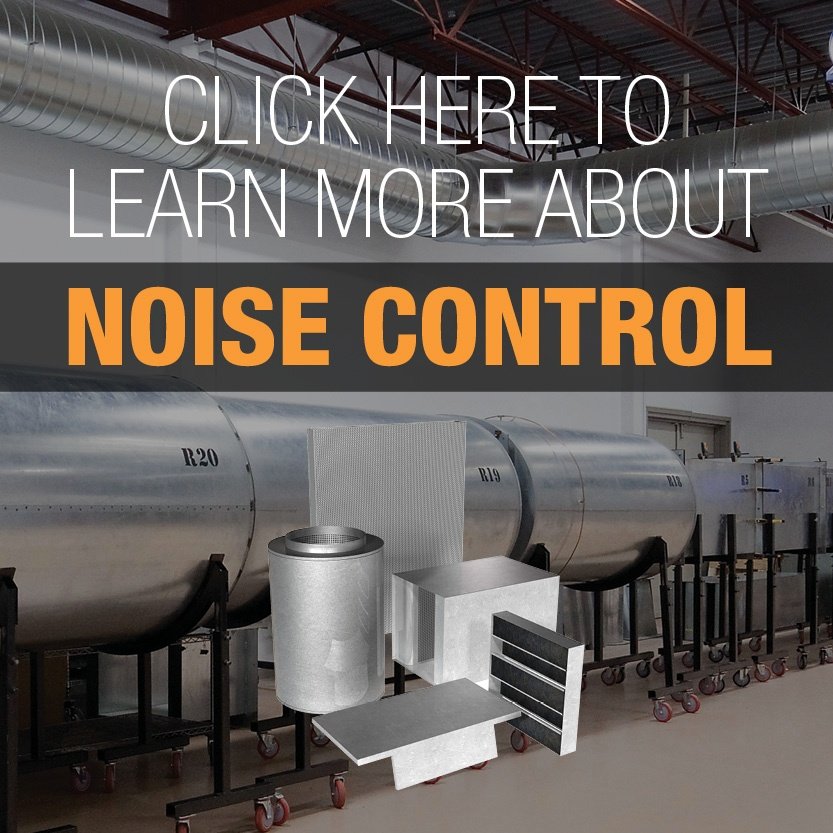System Testing to Optimize Terminal Unit Acoustics
In many commercial HVAC systems, engineers pair VAV boxes, fan-powered boxes and fan coils with duct silencers to meet the acoustical requirements of a space. While all the components are tested to industry standards – AHRI 880 and AHRI 260 for terminal units and fan coils and ASTM E477-20 for silencers – the combination of these two categories in real-world installations isn’t always straightforward.
In particular, close coupling a silencer directly to a terminal unit without proper consideration of the airflow and acoustical interaction can lead to unexpected performance issues. Let’s explore why this is and how system-level testing offers a better path forward.
 |
|
| A silencer close coupled to the discharge of a VAV box; a common installation in sound-sensitive commercial projects |
The Risks: Mismatched Data and Unrealistic Assumptions
AHRI Standard 880, Performance Rating of Air Terminals and AHRI Standard 260, Sound Rating of Ducted Air Moving and Conditioning Equipment provide a standardized method for measuring radiated and discharge sound power, as well as pressure drop and airflow modulation. ASTM E477-20, Standard Test Method for Laboratory Measurements of Acoustical and Airflow Performance of Duct Liner Materials and Prefabricated Silencers evaluates the insertion loss, airflow-generated noise (often shortened to AGN) and pressure drop of duct silencers – but under carefully controlled laboratory conditions.
Specifically, ASTM E477-20 requires a minimum of five equivalent duct diameters of straight duct upstream of the silencer and 10 duct diameters of unobstructed duct downstream during testing (ideal conditions). This ensures smooth, uniform laminar airflow so that performance can be compared under the same parameters across different manufacturers. Although this may be the model case for achieving maximum attenuation and minimal airflow-generated noise, that’s rarely how silencers are installed in the field.
When silencers are close coupled to terminal units, the inlet conditions are far from ideal. Discharge from the terminal may include turbulence, swirl and velocity gradients, especially if a damper, coil or elbow is involved.
 |
| As seen above, the length of open duct between a silencer and terminal unit or fan coil can have a major influence on airflow turbulence and localized velocity |
What Happens When Inlet Conditions Are Poor?
Close-coupled installations with turbulent inlet conditions can introduce several performance problems:
- Increased Self-Generated Noise: Turbulence interacting with silencer baffles generates additional airflow noise, often in the same frequency range the silencer was intended to reduce.
- Higher Pressure Drop: Unstable airflow causes flow separation and additional friction losses, increasing fan energy and, as a result, fan noise.
- Higher Fan Sound Power Levels: This occurs as the pressure drop increases; the fan needs to ramp up to overcome back pressure.
- Nonuniform Velocity Profiles: This can reduce the overall acoustical performance, especially in the critical low-frequency range.
The result? A silencer that looks great on paper but underperforms in the ductwork.
A Better Approach: System-Level Testing per AHRI Standards 880 and 260
To avoid these risks, it’s best to test the terminal unit and silencer together in a close-coupled configuration under AHRI 880 and 260. This simulates real-world airflow conditions and gives designers reliable, system-level performance data.
Benefits of system testing include the following:
- Realistic airflow-generated noise that reflects turbulence from the terminal unit
- Accurate pressure drop across both components
- True discharge and radiated sound power based on how the system will actually operate
No assumptions, no guesswork – just performance you can trust.
Final Thoughts
When silencers are tested in the lab in ideal conditions, the results don’t reflect what happens in a crowded ceiling plenum or duct layout. If you're close coupling a silencer to a terminal unit, make sure the acoustical data comes from a test that mirrors reality.
Because when silence matters, testing conditions matter even more.
Questions about terminal units or silencers? Reach out to our Air Moving team at airmovement@priceindustries.com or our Noise Control team at noisecontrol@priceindustries.com.
 |
Mauricio Salinas is Application Engineering Manager for Price's Noise Control team. He is based out of Price's headquarters in Winnipeg, MB. Click here to connect with him on LinkedIn. |
|
Mark Mahon is Business Development Manager for US Sales. He is based out of Price's facility in Suwanee, GA. Click here to connect with him on LinkedIn. |





